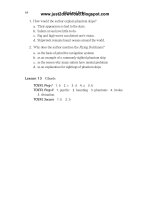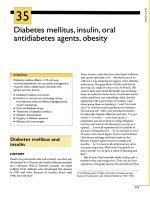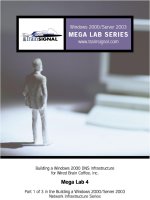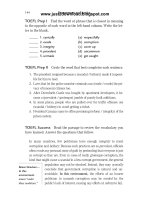Tài liệu Clinical Anatomy: Applied Anatomy for Students and Junior Doctors pdf
Bạn đang xem bản rút gọn của tài liệu. Xem và tải ngay bản đầy đủ của tài liệu tại đây (18.2 MB, 455 trang )
Clinical Anatomy
Applied anatomy for students and junior doctors
Harold Ellis
ELEVENTH EDITION
Clinical Anatomy
ECAPR 7/18/06 6:33 PM Page i
To my wife and late parents
ECAPR 7/18/06 6:33 PM Page ii
Clinical Anatomy
A revision and applied anatomy
for clinical students
HAROLD◊ ELLIS
CBE, MA, DM, MCh, FRCS, FRCP, FRCOG, FACS (Hon)
Clinical Anatomist, Guy’s, King’s and
St Thomas’ School of Biomedical Sciences;
Emeritus Professor of Surgery, Charing Cross
and Westminster Medical School, London;
Formerly Examiner in Anatomy, Primary FRCS (Eng)
ELEVENTH EDITION
ECAPR 7/18/06 6:33 PM Page iii
© 2006 Harold Ellis
Published by Blackwell Publishing Ltd
Blackwell Publishing, Inc., 350 Main Street, Malden, Massachusetts 02148-5020, USA
Blackwell Publishing Ltd, 9600 Garsington Road, Oxford OX4 2DQ, UK
Blackwell Publishing Asia Pty Ltd, 550 Swanston Street, Carlton, Victoria 3053,
Australia
The right of the Author to be identified as the Author of this Work has been asserted
in accordance with the Copyright, Designs and Patents Act 1988.
All rights reserved. No part of this publication may be reproduced, stored in a
retrieval system, or transmitted, in any form or by any means, electronic,
mechanical, photocopying, recording or otherwise, except as permitted by the UK
Copyright, Designs and Patents Act 1988, without the prior permission of the
publisher.
First published 1960 Seventh edition 1983
Second edition 1962 Revised reprint 1986
Reprinted 1963 Eighth edition 1992
Third edition 1966 Ninth edition 1992
Fourth edition 1969 Reprinted 2000
Fifth edition 1971 Tenth edition 2002
Sixth edition 1977 Reprinted 2003, 2004
Reprinted 1978, 1980 Greek edition 1969
Eleventh edition 2006
1 2006
Library of Congress Cataloging-in-Publication Data
Data available
ISBN-13: 978-1-4051-3804-8
ISBN-10: 1-4051-3804-1
A catalogue record for this title is available from the British Library
Set in 9/12 Palatino by SNP Best-set Typesetter Ltd., Hong Kong
Printed and bound in India by Replika Press Pvt Ltd
Commissioning Editor: Martin Sugden
Editorial Assistant: Ellie Bonnett
Development Editor: Mirjana Misina
Production Controller: Kate Charman
For further information on Blackwell Publishing, visit our website:
The publisher’s policy is to use permanent paper from mills that operate a
sustainable forestry policy, and which has been manufactured from pulp processed
using acid-free and elementary chlorine-free practices. Furthermore, the publisher
ensures that the text paper and cover board used have met acceptable
environmental accreditation standards.
Blackwell Publishing makes no representation, express or implied, that the drug
dosages in this book are correct. Readers must therefore always check that any
product mentioned in this publication is used in accordance with the prescribing
information prepared by the manufacturers. The author and the publishers do not
accept responsibility or legal liability for any errors in the text or for the misuse or
misapplication of material in this book.
ECAPR 7/18/06 6:33 PM Page iv
Contents
Preface, xiii
Acknowledgements, xiv
Part 1:◊The Thorax
Surface anatomy and surface markings, 3
◊◊Surface markings of the more important thoracic contents, 3
The thoracic cage, 7
◊◊The thoracic vertebrae, 7
◊◊The ribs, 7
◊◊The costal cartilages, 10
◊◊The sternum, 11
◊◊The intercostal spaces, 11
◊◊The diaphragm, 14
◊◊The pleurae, 18
The lower respiratory tract, 19
◊◊The trachea, 19
◊◊The bronchi, 23
◊◊The lungs, 23
The mediastinum, 28
◊◊The pericardium, 28
◊◊The heart, 29
◊◊The superior mediastinum, 42
◊◊The oesophagus, 42
◊◊The thoracic duct, 45
◊◊The thoracic sympathetic trunk, 47
On the examination of a chest radiograph, 49
◊◊Radiographic appearance of the heart, 50
Part 2:◊The Abdomen and Pelvis
Surface anatomy and surface markings, 55
◊◊Vertebral levels, 55
◊◊Surface markings, 55
The fasciae and muscles of the abdominal wall, 58
◊◊Fasciae of the abdominal wall, 58
◊◊The muscles of the anterior abdominal wall, 58
ECAPR 7/18/06 6:34 PM Page v
◊◊The anatomy of abdominal incisions, 61
◊◊The inguinal canal, 63
Peritoneal cavity, 65
◊◊Intraperitoneal fossae, 68
◊◊The subphrenic spaces, 69
The gastrointestinal tract, 70
◊◊The stomach, 70
◊◊The duodenum, 75
◊◊Small intestine, 77
◊◊Large intestine, 78
◊◊The appendix, 79
◊◊The rectum, 81
◊◊Arterial supply of the intestine, 86
◊◊The portal system of veins, 87
◊◊Lymph drainage of the intestine, 88
◊◊The structure of the alimentary canal, 88
◊◊The development of the intestine and its congenital abnormalities, 90
The gastrointestinal adnexae: liver, gall-bladder and its
ducts, pancreas and spleen, 93
◊◊The liver, 93
◊◊The biliary system, 98
◊◊The gall-bladder, 99
◊◊The pancreas, 101
◊◊The spleen, 104
The urinary tract, 105
◊◊The kidneys, 105
◊◊The ureter, 109
◊◊The embryology and congenital abnormalities of the kidney and
ureter, 110
◊◊The bladder, 112
◊◊The urethra, 115
The male genital organs, 116
◊◊The prostate, 116
◊◊The scrotum, 119
◊◊Testis and epididymis, 119
◊◊Vas deferens (ductus deferens), 123
◊◊The seminal vesicles, 124
The bony and ligamentous pelvis, 124
◊◊The os innominatum, 124
◊◊The sacrum, 125
◊◊The coccyx, 126
◊◊The functions of the pelvis, 126
vi Contents
ECAPR 7/18/06 6:34 PM Page vi
◊◊Joints and ligamentous connections of the pelvis, 127
◊◊Differences between the male and female pelvis, 128
◊◊Obstetrical pelvic measurements, 128
◊◊Variations of the pelvic shape, 130
The muscles of the pelvic floor and perineum, 132
◊◊The anterior (urogenital) perineum, 133
◊◊The posterior (anal) perineum, 134
The female genital organs, 136
◊◊The vulva, 136
◊◊The vagina, 137
◊◊The uterus, 139
◊◊The Fallopian tubes, 144
◊◊The ovary, 145
◊◊The endopelvic fascia and the pelvic ligaments, 146
◊◊Vaginal examination, 147
◊◊Embryology of the Fallopian tubes, uterus and vagina, 148
The posterior abdominal wall, 149
◊◊The suprarenal glands, 151
◊◊Abdominal aorta, 151
◊◊Inferior vena cava, 153
◊◊Lumbar sympathetic chain, 153
Part 3:◊The Upper Limb
The female breast, 159
◊◊Structure, 159
◊◊Blood supply, 159
◊◊Lymphatic drainage, 159
◊◊Development, 161
Surface anatomy and surface markings of the
upper limb, 162
◊◊Bones and joints, 163
◊◊Muscles and tendons, 164
◊◊Vessels, 166
◊◊Nerves, 167
The bones and joints of the upper limb, 168
◊◊The scapula, 168
◊◊The clavicle, 168
◊◊The humerus, 169
◊◊The radius and ulna, 171
◊◊The bones of the hand, 174
◊◊The shoulder, 176
◊◊The elbow joints, 180
Contents vii
ECAPR 7/18/06 6:34 PM Page vii
◊◊The wrist joint, 183
◊◊The joints of the hand, 184
The arteries of the upper limb, 186
◊◊The axillary artery, 186
◊◊The brachial artery, 187
◊◊The radial artery, 187
◊◊The ulnar artery, 188
The brachial plexus, 189
◊◊The segmental cutaneous supply of the upper limb, 191
The course and distribution of the principal nerves of the
upper limb, 191
◊◊The axillary nerve, 191
◊◊The radial nerve, 192
◊◊Branches, 194
◊◊The musculocutaneous nerve, 194
◊◊The ulnar nerve, 194
◊◊The median nerve, 195
The anatomy of upper limb deformities, 197
The spaces of the hand, 200
◊◊The superficial pulp space of the fingers, 200
◊◊The ulnar and radial bursae and the synovial tendon sheaths of the
fingers, 201
Part 4:◊The Lower Limb
The anatomy and surface markings of the lower limb, 207
◊◊Bones and joints, 207
◊◊Bursae of the lower limb, 207
◊◊Mensuration in the lower limb, 208
◊◊Muscles and tendons, 211
◊◊Vessels, 211
◊◊Nerves, 214
The bones and joints of the lower limb, 216
◊◊The os innominatum, 216
◊◊The femur, 216
◊◊The patella, 220
◊◊The tibia, 223
◊◊The fibula, 224
◊◊A note on growing ends and nutrient foramina in the long bones, 225
◊◊The bones of the foot, 225
◊◊The hip, 226
viii Contents
ECAPR 7/18/06 6:34 PM Page viii
Contents ix
◊◊The knee joint, 229
◊◊The tibiofibular joints, 233
◊◊The ankle, 233
◊◊The joints of the foot, 234
◊◊The arches of the foot, 235
◊◊The anatomy of walking, 237
Three important zones of the lower limb
—
the femoral
triangle, adductor canal and popliteal fossa, 237
◊◊The femoral triangle, 237
◊◊The fascia lata, 238
◊◊The femoral sheath and femoral canal, 238
◊◊Femoral hernia, 239
◊◊The lymph nodes of the groin and the lymphatic drainage of the lower
limb, 241
◊◊The adductor canal (of Hunter) or subsartorial canal, 242
◊◊The popliteal fossa, 242
The arteries of the lower limb, 244
◊◊Femoral artery, 244
◊◊Popliteal artery, 246
◊◊Posterior tibial artery, 246
◊◊Anterior tibial artery, 246
The veins of the lower limb, 247
◊◊Clinical features, 249
The course and distribution of the principal nerves of the
lower limb, 249
◊◊The lumbar plexus, 250
◊◊The sacral plexus, 251
◊◊The sciatic nerve, 253
◊◊The tibial nerve, 255
◊◊The common peroneal (fibular) nerve, 255
◊◊Segmental cutaneous supply of the lower limb, 256
Part 5:◊The Head and Neck
The surface anatomy of the neck, 261
◊◊The fascial compartments of the neck, 262
The thyroid gland, 264
◊◊The parathyroid glands, 267
The palate, 270
◊◊The development of the face, lips and palate with special reference to
their congenital deformities, 270
ECAPR 7/18/06 6:34 PM Page ix
The tongue and floor of the mouth, 272
◊◊The tongue, 272
◊◊The floor of the mouth, 276
The pharynx, 277
◊◊The nasopharynx, 277
◊◊The oropharynx, 278
◊◊The palatine tonsils, 279
◊◊The laryngopharynx, 280
◊◊The mechanism of deglutition, 282
The larynx, 284
◊◊Blood supply, 287
◊◊Lymph drainage, 287
◊◊Nerve supply, 288
The salivary glands, 289
◊◊The parotid gland, 289
◊◊The submandibular gland, 292
◊◊The sublingual gland, 293
The major arteries of the head and neck, 294
◊◊The common carotid arteries, 294
◊◊The external carotid artery, 294
◊◊The internal carotid artery, 296
◊◊The subclavian arteries, 298
The veins of the head and neck, 301
◊◊The cerebral venous system, 301
◊◊The venous sinuses of the dura, 301
◊◊The internal jugular vein, 303
◊◊The subclavian vein, 305
The lymph nodes of the neck, 306
The cervical sympathetic trunk, 308
The branchial system and its derivatives, 310
◊◊Branchial cyst and fistula, 310
The surface anatomy and surface markings of the head, 311
The scalp, 312
The skull, 314
◊◊Development, 316
x Contents
ECAPR 7/18/06 6:34 PM Page x
Contents xi
The accessory nasal sinuses, 318
◊◊The frontal sinuses, 318
◊◊The maxillary sinus (antrum of Highmore), 319
◊◊The ethmoid sinuses, 320
◊◊The sphenoid sinuses, 321
The mandible, 321
◊◊The temporomandibular joint, 322
◊◊The teeth, 323
The vertebral column, 324
◊◊The cervical vertebrae, 325
◊◊The thoracic vertebrae, 327
◊◊The lumbar vertebrae, 327
◊◊The sacrum, 327
◊◊The coccyx, 327
◊◊The intervertebral joints, 328
Part 6:◊The Central Nervous System
The spinal cord, 333
◊◊Age differences, 333
◊◊Structure, 333
◊◊Descending tracts, 334
◊◊Ascending tracts, 336
◊◊The membranes of the cord (the meninges), 337
The brain, 339
◊◊The medulla, 339
◊◊The pons, 342
◊◊The cerebellum, 342
◊◊The midbrain, 344
◊◊The diencephalon, 346
◊◊The hypothalamus, 346
◊◊The pituitary gland (hypophysis cerebri), 347
◊◊The thalamus, 349
◊◊The cerebral hemispheres, 349
◊◊The cerebral cortex, 349
◊◊The insula, 352
◊◊The connections of the cerebral cortex, 352
◊◊The basal ganglia, 353
◊◊The long ascending and descending pathways, 354
◊◊The membranes of the brain (the meninges), 360
◊◊The ventricular system and the cerebrospinal fluid circulation, 361
The cranial nerves, 364
◊◊The olfactory nerve (I), 364
◊◊The optic nerve (II) and the visual pathway, 365
ECAPR 7/18/06 6:34 PM Page xi
◊◊The oculomotor nerve (III), 366
◊◊The trochlear nerve (IV), 368
◊◊The trigeminal nerves (V), 369
◊◊The abducent nerve (VI), 374
◊◊The facial nerve (VII), 375
◊◊The auditory (vestibulocochlear) nerve (VIII), 377
◊◊The glossopharyngeal nerve (IX), 379
◊◊The vagus nerve (X), 379
◊◊The accessory nerve (XI), 381
◊◊The hypoglossal nerve (XII), 381
The special senses, 383
◊◊The nose, 383
◊◊The ear, 384
◊◊The eye and associated structures, 388
The autonomic nervous system, 393
◊◊Visceral afferents, 396
◊◊The sympathetic system, 396
◊◊The sympathetic trunk, 396
◊◊The parasympathetic system, 399
Glossary of eponyms, 403
Index, 409
xii Contents
Preface
Experience of teaching clinical students at five medical schools and of
examining them in sixteen cities and in eight countries has convinced me
that there is still an unfortunate hiatus between the anatomy which the
student learns in the pre-clinical years and that which is later encountered
in the wards and operating theatres.
This book attempts to counter this situation. It does so by highlighting
those features of anatomy which are of clinical importance using a vertical
blue bar, in radiology, pathology, medicine and midwifery as well as in
surgery. It presents the facts which students might reasonably be expected
to carry with them during their years on the wards, through their final
examinations and into their postgraduate years; it is designed for the clini-
cal student.
Anatomy is a vast subject and, therefore, in order to achieve this goal, I
have deliberately carried out a rigorous selection of material so as to cover
only those of its thousands of facts which I consider form the necessary
anatomical scaffolding for the clinician. Wherever possible practical appli-
cations are indicated throughout the text
—
they cannot, within the limita-
tions of a book of this size, be exhaustive, but I hope that they will act as
signposts to the student and indicate how many clinical phenomena can be
understood and remembered on simple anatomical grounds.
In this eleventh edition a complete revision of the text has been carried
out. New figures have been added and other illustrations modified. Repre-
sentative computerized axial tomography and magnetic resonance
imaging films have been included, since these techniques have given
increased impetus to the clinical importance of topographical anatomy.
The continued success of this volume, now in its forty-seventh year of
publication, owes much to the helpful comments which the author has
received from readers all over the world. Every suggestion is given the
most careful consideration in an attempt to keep the material abreast of the
needs of today’s medical students.
Harold Ellis
2006
xiii
ECAPR 7/18/06 6:35 PM Page xiii
Acknowledgements
xiv
I wish to thank the many students who have sent suggestions to me, many
of which have been incorporated into this new edition.
To Mrs Katherine Ellis go my grateful thanks for invaluable secretarial
assistance. New and revised illustrations were skilfully produced by Jane
Fallows and new MR scans were provided by Dr Sheila Rankin of the
Department of Radiology at Guy’s Hospital and Professor Adrian Dixon of
Cambridge.
I am grateful to the following authors for permission to reproduce illus-
trations:
The late Lord Brock for Figs 20 and 21 (from Lung Abscess); and
Professor R. G. Harrison for Figs 12, 32 and 69 (from ATextbook of Human
Embryology).
Dr Colin Stolkin gave valuable help in revising the anatomy of the
C.N.S.
Finally, I wish to express my debt to Martin Sugden and the staff of
Blackwell Publishing for their continued and unfailing help.
Harold Ellis
ECAPR 7/18/06 6:35 PM Page xiv
Part 1
The Thorax
ECA1 7/18/06 6:30 PM Page 1
ECA1 7/18/06 6:30 PM Page 2
Surface anatomy and
surface markings
The experienced clinician spends much of his working life relating the
surface anatomy of his patients to their deep structures (Fig. 1; see also
Figs. 11 and 22).
The following bony prominences can usually be palpated in the living
subject (corresponding vertebral levels are given in brackets):
•◊◊superior angle of the scapula (T2);
•◊◊upper border of the manubrium sterni, the suprasternal notch (T2/3);
•◊◊spine of the scapula (T3);
•◊◊sternal angle (of Louis)
—
the transverse ridge at the manubrio-sternal
junction (T4/5);
•◊◊inferior angle of scapula (T8);
•◊◊xiphisternal joint (T9);
•◊◊lowest part of costal margin
—
10th rib (the subcostal line passes through
L3).
Note from Fig. 1 that the manubrium corresponds to the 3rd and 4th
thoracic vertebrae and overlies the aortic arch, and that the sternum corre-
sponds to the 5th to 8th vertebrae and neatly overlies the heart.
Since the 1st and 12th ribs are difficult to feel, the ribs should be enu-
merated from the 2nd costal cartilage, which articulates with the sternum at
the angle of Louis.
The spinous processes of all the thoracic vertebrae can be palpated in
the midline posteriorly, but it should be remembered that the first spinous
process that can be felt is that of C7 (the vertebra prominens).
The position of the nipple varies considerably in the female, but in the
male it usually lies in the 4th intercostal space about 4in (10cm) from the
midline. The apex beat, which marks the lowest and outermost point at
which the cardiac impulse can be palpated, is normally in the 5th inter-
costal space 3.5in (9cm) from the midline (just below and medial to the
nipple).
The trachea is palpable in the suprasternal notch midway between the
heads of the two clavicles.
Surface markings of the more important
thoracic contents
(Figs 2–4)
The trachea
The trachea commences in the neck at the level of the lower border of the
cricoid cartilage (C6) and runs vertically downwards to end at the level of
the sternal angle of Louis (T4/5), just to the right of the mid-line, by divid-
ing to form the right and left main bronchi. In the erect position and in full
inspiration the level of bifurcation is at T6.
3
ECA1 7/18/06 6:30 PM Page 3
4 The Thorax
Fig. 1◊Lateral view of the
thorax
—
its surface
markings and vertebral
levels. (Note that the
angle of Louis (T4/5)
demarcates the superior
mediastinum, the upper
margin of the heart and
the beginning and end of
the aortic arch.)
Fig. 2◊The surface markings of the lungs and pleura
—
anterior view.
ECA1 7/18/06 6:30 PM Page 4
Surface anatomy and surface markings 5
The pleura
The cervical pleura can be marked out on the surface by a curved line drawn
from the sternoclavicular joint to the junction of the medial and middle
thirds of the clavicle; the apex of the pleura is about 1in (2.5cm) above
the clavicle. This fact is easily explained by the oblique slope of the first rib.
It is important because the pleura can be wounded (with consequent
Fig. 3◊The surface
markings of the lungs
and pleura
—
posterior
view.
Fig. 4◊The surface
markings of the heart (see
text).
ECA1 7/18/06 6:30 PM Page 5
pneumothorax) by a stab wound
—
and this includes the surgeon’s knife
and the anaesthetist’s needle
—
above the clavicle.
The lines of pleural reflexion pass from behind the sternoclavicular joint
on each side to meet in the midline at the 2nd costal cartilage (the angle of
Louis). The right pleural edge then passes vertically downwards to the 6th
costal cartilage and then crosses:
•◊◊the 8th rib in the midclavicular line;
•◊◊the 10th rib in the midaxillary line;
•◊◊the 12th rib at the lateral border of the erector spinae.
On the left side the pleural edge arches laterally at the 4th costal carti-
lage and descends lateral to the border of the sternum, due, of course, to its
lateral displacement by the heart; apart from this, its relationships are those
of the right side.
The pleura actually descends just below the 12th rib margin at its
medial extremity
—
or even below the edge of the 11th rib if the 12th is
unusually short; obviously in this situation the pleura may be opened acci-
dentally in making a loin incision to expose the kidney, perform an adrena-
lectomy or to drain a subphrenic abscess.
The lungs
The surface projection of the lung is somewhat less extensive than that of
the parietal pleura as outlined above, and in addition it varies quite consid-
erably with the phase of respiration. The apex of the lung closely follows the
line of the cervical pleura and the surface marking of the anterior border of the
right lung corresponds to that of the right mediastinal pleura. On the left
side, however, the anterior border has a distinct notch (the cardiac notch)
which passes behind the 5th and 6th costal cartilages. The lower border of the
lung has an excursion of as much as 2–3in (5–8cm) in the extremes of respi-
ration, but in the neutral position (midway between inspiration and expira-
tion) it lies along a line which crosses the 6th rib in the midclavicular line,
the 8th rib in the midaxillary line, and reaches the 10th rib adjacent to the
vertebral column posteriorly.
The oblique fissure, which divides the lung into upper and lower lobes, is
indicated on the surface by a line drawn obliquely downwards and out-
wards from 1in (2.5cm) lateral to the spine of the 5th thoracic vertebra to
the 6th costal cartilage about 1.5in (4cm) from the midline. This can be rep-
resented approximately by abducting the shoulder to its full extent; the line
of the oblique fissure then corresponds to the position of the medial border
of the scapula.
The surface markings of the transverse fissure (separating the middle and
upper lobes of the right lung) is a line drawn horizontally along the 4th
costal cartilage and meeting the oblique fissure where the latter crosses the
5th rib.
The heart
The outline of the heart can be represented on the surface by the
irregular quadrangle bounded by the following four points (Fig. 4):
6 The Thorax
ECA1 7/18/06 6:30 PM Page 6
The thoracic cage 7
1◊◊the 2nd left costal cartilage 0.5in (12mm) from the edge of the sternum;
2◊◊the 3rd right costal cartilage 0.5in (12mm) from the sternal edge;
3◊◊the 6th right costal cartilage 0.5in (12mm) from the sternum;
4◊◊the 5th left intercostal space 3.5in (9cm) from the midline (correspond-
ing to the apex beat).
The left border of the heart (indicated by the curved line joining points
1 and 4) is formed almost entirely by the left ventricle (the auricular
appendage of the left atrium peeping around this border superiorly), the
lower border (the horizontal line joining points 3 and 4) corresponds to the
right ventricle and the apical part of the left ventricle; the right border
(marked by the line joining points 2 and 3) is formed by the right atrium
(see Fig. 24a).
A good guide to the size and position of your own heart is given by
placing your clenched right fist palmar surface down immediately inferior
to the manubriosternal junction. Note that the heart is about the size of the
subject’s fist, lies behind the body of the sternum (therefore anterior to tho-
racic vertebrae 5–8), and bulges over to the left side.
The surface markings of the vessels of the thoracic wall are of im-
portance if these structures are to be avoided in performing aspiration
of the chest. The internal thoracic (internal mammary) vessels run vertically
downwards behind the costal cartilages half an inch from the lateral
border of the sternum. The intercostal vessels lie immediately below
their corresponding ribs (the vein above the artery) so that it is safe to pass
a needle immediately above a rib, dangerous to pass it immediately below
(see Fig. 8).
The thoracic cage
The thoracic cage is formed by the vertebral column behind, the ribs and
intercostal spaces on either side and the sternum and costal cartilages in
front. Above, it communicates through the ‘thoracic inlet’ with the root
of the neck; below, it is separated from the abdominal cavity by the
diaphragm (Fig. 1).
The thoracic vertebrae
See ‘vertebral column’, page 327.
The ribs
The greater part of the thoracic cage is formed by the twelve pairs of ribs.
Of these, the first seven are connected anteriorly by way of their costal
cartilages to the sternum, the cartilages of the 8th, 9th and 10th articulate
each with the cartilage of the rib above (‘false ribs’) and the last two ribs are
free anteriorly (‘floating ribs’).
Each typical rib (Fig. 5) has a head bearing two articular facets, for
ECA1 7/18/06 6:30 PM Page 7
articulation with the numerically corresponding vertebra and the vertebra
above, a stout neck, which gives attachment to the costotransverse liga-
ments, a tubercle with a rough non-articular portion and a smooth facet, for
articulation with the transverse process of the corresponding vertebra, and
a long shaft flattened from side to side and divided into two parts by the
‘angle’ of the rib. The angle demarcates the lateral limit of attachment of the
erector spinae muscle.
The following are the significant features of the ‘atypical’ ribs.
1st Rib (Fig. 6). This is flattened from above downwards. It is not
only the flattest but also the shortest and most curvaceous of all the ribs. It
has a prominent tubercle on the inner border of its upper surface for the
8 The Thorax
Fig. 5◊A typical rib.
Fig. 6◊Structures crossing the first rib.
ECA1 7/18/06 6:30 PM Page 8
insertion of scalenus anterior. In front of this tubercle, the subclavian vein
crosses the rib; behind the tubercle is the subclavian groove where the subcla-
vian artery and lowest trunk of the brachial plexus lie in relation to the
bone. It is here that the anaesthetist can infiltrate the plexus with local
anaesthetic.
Crossing the neck of the first rib from the medial to the lateral side are
the sympathetic trunk, the superior intercostal artery (from the costocervi-
cal trunk) and the large branch of the first thoracic nerve to the brachial
plexus.
The 2nd rib is much less curved than the 1st and about twice as long.
The 10th rib has only one articular facet on the head.
The 11th and 12th ribs are short, have no tubercles and only a single facet
on the head. The 11th rib has a slight angle and a shallow subcostal groove;
the 12th has neither of these features.
Clinical features
Rib fractures
The chest wall of the child is highly elastic and therefore fractures of the rib
in children are rare. In adults, the ribs may be fractured by direct violence or
indirectly by crushing injuries; in the latter the rib tends to give way at its
weakest part in the region of its angle. Not unnaturally, the upper two ribs,
which are protected by the clavicle, and the lower two ribs, which are unat-
tached and therefore swing free, are the least commonly injured.
In a severe crush injury to the chest several ribs may fracture in front
and behind so that a whole segment of the thoracic cage becomes torn free
(‘stove-in chest’). With each inspiration this loose flap sucks in, with each
expiration it blows out, thus undergoing paradoxical respiratory move-
ment. The associated swinging movements of the mediastinum produce
severe shock and this injury calls for urgent treatment by insertion of a
chest drain with underwater seal, followed by endotracheal intubation, or
tracheostomy, combined with positive pressure respiration.
Coarctation of the aorta (see Fig. 34b and page 41)
In coarctation of the aorta, the intercostal arteries derived from the aorta
receive blood from the superior intercostals (from the costocervical trunk of
the subclavian artery), from the anterior intercostal branches of the internal
thoracic artery (arising from the subclavian artery) and from the arteries
anastomosing around the scapula. Together with the communication
between the internal thoracic and inferior epigastric arteries, they provide
the principal collaterals between the aorta above and below the block. In
consequence, the intercostal arteries undergo dilatation and tortuosity and
erode the lower borders of the corresponding ribs to give the characteristic
irregular notching of the ribs, which is very useful in the radiographic confir-
mation of this lesion.
The thoracic cage 9
ECA1 7/18/06 6:30 PM Page 9
Fig. 7◊Bilateral cervical ribs. On the right side the brachial plexus is shown arching
over the rib and stretching its lowest trunk.
Cervical rib
A cervical rib (Fig. 7) occurs in 0.5% of subjects and is bilateral in half of
these. It is attached to the transverse process of the 7th cervical vertebra and
articulates with the 1st (thoracic) rib or, if short, has a free distal extremity
which usually attaches by a fibrous strand to the (normal) first rib. Pressure
of such a rib on the lowest trunk of the brachial plexus arching over it may
produce paraesthesiae along the ulnar border of the forearm and wasting of
the small muscles of the hand (T1). Less commonly vascular changes, even
gangrene, may be caused by pressure of the rib on the overlying subclavian
artery. This results in post-stenotic dilatation of the vessel distal to the rib in
which a thrombus forms from which emboli are thrown off.
The costal cartilages
These bars of hyaline cartilage serve to connect the upper seven ribs
directly to the side of the sternum and the 8th, 9th and 10th ribs to
the cartilage immediately above. The cartilages of the 11th and 12th ribs
merely join the tapered extremities of these ribs and end in the abdominal
musculature.
10 The Thorax
ECA1 7/18/06 6:31 PM Page 10









